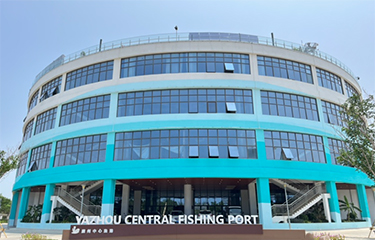Chinese seafood market rebounding amid uneven post-Covid boom

The opening in late April of a large sea leisure facility on the island of Hainan could be a sign China’s seafood market is rebounding.
The state-owned China Railway Construction Group built the Yazhou Central Fishing Port, what some have termed Hainan’s “largest sea leisure center.” The facility includes a 29,647-square-meter seafood trading center with a hotel, a shopping street, and restaurants featuring fresh seafood in the popular tourist city of Sanya.
Timed to open for the weeklong May holiday and operated by the local government, the imposing new structure has tested the market for seafood and consumer spending at a time when domestic tourism has returned to some semblance of normalcy.
The new sea leisure center opened when seafood imports, in terms of volume, have surged this year in China. In the first quarter, China’s imports of chilled and frozen Atlantic salmon jumped 53 percent, half of it from Norway.
“The price of Atlantic salmon imported by China has risen year on year, especially in March,” said Vanessa Jiang, supply chain manager at the China Supply and Marketing Agricultural Production Wholesale Market Holding Co. Ltd. (CAWM) West Coast Market in Qingdao.
Jiang told SeafoodSource she sees signs of restocking by Chinese importers who held off on purchasing during the pandemic due to weak demand and fears of possible product detention at ports. For example, imports of frozen warmwater shrimp hit a five-year high in monthly measurements in March, according to Jiang, with over 100,000 metric tons arriving at Chinese ports. In total, 81 percent of the imported volume came from Ecuador, which supplied 83,000 metric tons imported.
That restocking is a direct result of demand, which Qingdao-based importer Joe Qiao told SeafoodSource is steady but not spectacular.
“Sales are solid, but consumers remain worried about the economy,” said Qiao, head of Qingdao-based Meichu Foods, which focuses on frozen imports and sells under the Wo Ai Yu brand.
Structural demand for seafood will remain strong in China, Qiao predicted, due to a falloff in local supply.
“China is short on seafood; It was number one for farming fish, but now, this has peaked and is going down,” Qiao said.
For that reason, Qiao traveled to Seafood Expo Global (SEG) in Barcelona, Spain, in April, to look for more suppliers who can partner with his firm to expand sales in China.
“We are looking for suppliers to develop the Chinese market together,” he said. “Financing is very expensive in China, so we want a supplier who can help us expand. We’re looking for all kinds of products: salmon, cod, mackerel, etcetera.”
There are, however, signs of weaker demand driving an unequal recovery …
Photo courtesy of China Railway Construction Group





Share